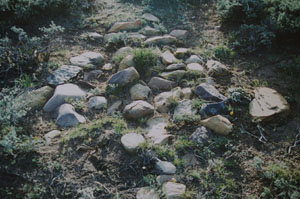 Brigham's Arrow* This is a four by six foot arrow of rock placed in the ground. According to the latitude and longitude readings of Orson Pratt, at this point the Vanguard's travels switched directions from an old Indian trail. It is strongly believed that the Vanguard Company, with Brigham Young laid this arrow in the ground for the other companies of saints to follow.
Brigham's Arrow* This is a four by six foot arrow of rock placed in the ground. According to the latitude and longitude readings of Orson Pratt, at this point the Vanguard's travels switched directions from an old Indian trail. It is strongly believed that the Vanguard Company, with Brigham Young laid this arrow in the ground for the other companies of saints to follow.
Bigelow Springs* This is a very nice spring that still runs today. Alot of the pioneers stopped here for their lunch between Fort Bridger and the Muddy Crossing.
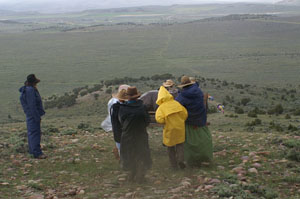 Gravel Hill* You will have to double up your strength as you descend down Gravel Hill. This was the steepest decent the pioneers had come across thus far in their travels.
Gravel Hill* You will have to double up your strength as you descend down Gravel Hill. This was the steepest decent the pioneers had come across thus far in their travels. 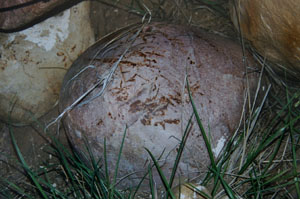 An attempt was made to zigzag the wagons down this hill and rock walls were built up on the corners to keep the wagons from tipping over. You can still see remains of the rock walls. Also on this hill and all along the trail you will see rocks with iron deposits left on them from the wagon and handcart wheels.
An attempt was made to zigzag the wagons down this hill and rock walls were built up on the corners to keep the wagons from tipping over. You can still see remains of the rock walls. Also on this hill and all along the trail you will see rocks with iron deposits left on them from the wagon and handcart wheels.
Muddy Camp & Crossing* Your first nights camp will be located here. When the pioneers arrived at this camp they were pleased with the bunch grass and good water for their stock. While you stay at this camp you will be able to view pioneer graves and remains of the Pony Express Stop. 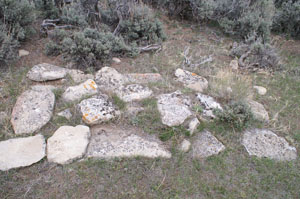 This was a heavily used camp on the trail. Between the years 1847 and 1869, 60- 70 thousand pioneers crossed through it, 250,000 immigrants going to California for the gold rush came through, and Captain Johnston's army of 2000 men camped here. The Pony Express ran through this camp and there was also a station here built by Moses Byrne.
This was a heavily used camp on the trail. Between the years 1847 and 1869, 60- 70 thousand pioneers crossed through it, 250,000 immigrants going to California for the gold rush came through, and Captain Johnston's army of 2000 men camped here. The Pony Express ran through this camp and there was also a station here built by Moses Byrne.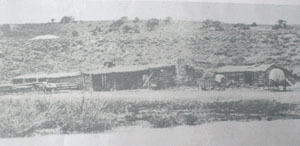 The stage line ran through here and the very first telegraph line went through this camp. Also within two miles from this camp ran the Lincoln Highway, and the first transcontinental railroad bed. In 1856 the rescue companies camped here with the Martin and Willey Handcart Companies on their way back to the Salt Lake Valley.
The stage line ran through here and the very first telegraph line went through this camp. Also within two miles from this camp ran the Lincoln Highway, and the first transcontinental railroad bed. In 1856 the rescue companies camped here with the Martin and Willey Handcart Companies on their way back to the Salt Lake Valley.
Known deaths on the Muddy Creek: Peter Andersen Phelsted, Anna Hansen, Catherine Jones Bennett, Anna Hansdatter Jensen, Lauritz Larsen
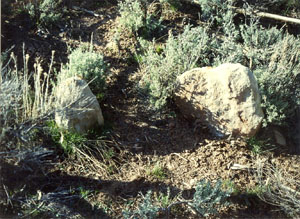 Williams Hollow* Your second night's camp will be here at the mouth of Williams Hollow. This hollow was named after a man by the name of William H Bedford. He was buried here July 4, 1852 aged 28. There are also other graves in this hollow that you will be able to view. In this hollow there is also a spring called Copperas Springs. This spring was mentioned in many journals as having a strong smell of copper and alum, and a nasty taste. Also from a distance running across the red soil it had the appearance of blood.
Williams Hollow* Your second night's camp will be here at the mouth of Williams Hollow. This hollow was named after a man by the name of William H Bedford. He was buried here July 4, 1852 aged 28. There are also other graves in this hollow that you will be able to view. In this hollow there is also a spring called Copperas Springs. This spring was mentioned in many journals as having a strong smell of copper and alum, and a nasty taste. Also from a distance running across the red soil it had the appearance of blood.
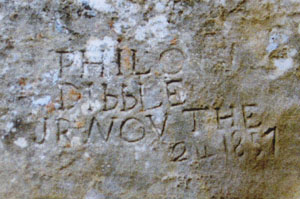 Dibble Rock* Your third day as you hike out you will have opportunity to view one of the neatest historical sites in this area. Here, Philo Dibble Jr. (while hiding out from Johnston's Army) carved his name in a huge sandstone rock. You will find a natural amphitheater perfect for a closing testimony meeting or fireside.
Dibble Rock* Your third day as you hike out you will have opportunity to view one of the neatest historical sites in this area. Here, Philo Dibble Jr. (while hiding out from Johnston's Army) carved his name in a huge sandstone rock. You will find a natural amphitheater perfect for a closing testimony meeting or fireside.
